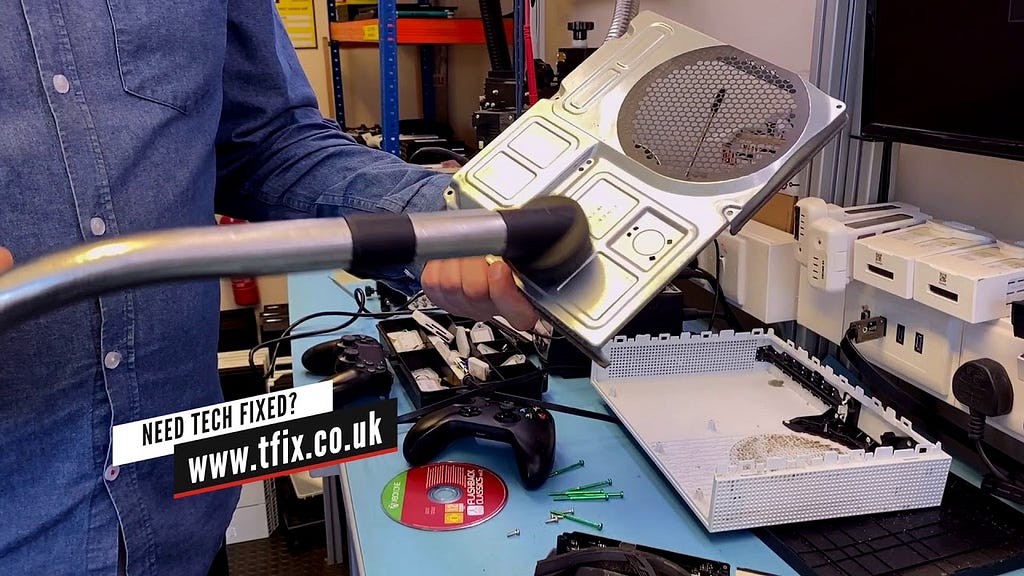Do Electronic Equipment Manufacturers Actually Want You to Repair?

The worst has happened.
The screen on your Nintendo Switch has started randomly freezing every time you play. There’s just no way you can continue to get your daily Splatoon or Zelda fix when it’s doing stupid things like this.

So what do you do? Do you have to go and fork out for a brand-new console? Or can you somehow repair the problem?
The answer to that question depends on what the problem is, what device you own and whether you’re under warranty. A screen problem might be fixable. Dropping it into the bath probably isn’t.
But there’s an extra factor, and it’s this: It seems like most electronic manufacturers don’t want you to get inside the device to fix it. How come?
In this blog, we’ll be answering that question and finding out why they might not want you to repair, why that isn’t entirely fair and how these manufacturers could benefit if they made repairs more accessible for us all.
Why are our electronic devices so hard to get into and repair?
If you’ve ever tried to open up your broken Nintendo Switch or Xbox console to repair it, you’ve likely found that it’s not easy to get in.
Either everything appears to be sealed shut. Or the screws are strangely shaped, and you don’t have the screwdriver that you need. Or you can’t figure out how it all comes apart, so you’re scared to death of making the issue even worse.

If so, you’re not alone. Here at TFix, we know all the tricks of the trade. We have that three-pointed, star-shaped screwdriver; we can desolder parts and melt away glue if we need to. But even we struggle. It does feel like the manufacturers want to make it as hard as possible for us to get in at times.
So why is this the case? Why don’t they want us to fix them?
It turns out that there are a couple of reasons.
1. Manufacturers don’t want you to die. If you don’t know what you’re doing, you could accidentally electrocute yourself and die. The last thing the manufacturers want is for you to get injured.
2. Companies want their tech designs to stay unique. These manufacturers have invested heavily to create the kinds of devices you’ll love (Nintendo are said to have invested over $527 in research and development in the last year alone. So the last thing they want you to do is to take the thing apart and start creating hybrid versions that create a Frankenstein version of their streamlined original.
3. Businesses want to make money from you. If they make it easier for you to repair your electronic device, you’re not going to buy as many of their products as you otherwise might. This won’t just affect their profits but could affect how much they can invest back into further development and technological advancements.
It’s not always intentional.
It’s worth reminding ourselves at this point that the manufacturers are people just like you and me. So while they want to take care of their customers and provide the best they can for them, they also need to keep profit in mind. If they don’t make money, they can’t continue to make these electronic devices that we love.
Additionally, our inability to open up the electronic equipment and repair often isn’t intentional on their part.
It happens because of the design. The manufacturers’ core focus is always going to be on performance and user experience, so factors such as the stuff inside the outer casing and its organisation aren’t so important. It varies depending on who the manufacturer is and the design itself.
For example, when you open up a Nintendo Switch, you’ll find a ton of stuff crowded into a tiny space. It’s an absolute mess. Yet the Xbox consoles are fantastic from a repair perspective. They work just like Lego- you can slot in and out the pieces however you like.
Again, this isn’t their fault. It’s the nature of tech design. We’re not supposed to be opening them up anyway.

Why they should allow us to repair our electronic equipment
Although we do understand why they don’t want us opening up our devices and poking around inside, we don’t think that it’s entirely fair. Here’s why.
It’s your device…
You’ve spent your hard-earned cash on your device so what you decide to do with it should be up to you!
That includes opening it up, fiddling around inside, replacing any broken components, or making whatever changes you want.
If you want to put your Mad Engineer hat on and slot in some in some additional memory, then you should be able to give it a try if you wish. It might not work, but surely that’s your call to make.
Repairing is better for the environment.
We should be able to breathe new life into our devices for as long as we physically can to help slow down the rate of climate change.
If we can squeeze five more years of life out of that old laptop instead of two, there will be less stuff kicking around in landfill, less consumption happening and less in the way of pollution too.

It makes tech more affordable.
Repairing your old tech means that you don’t have to fork out for brand new replacements.
This puts the money back in your pocket, so when you finally want to upgrade or invest in a better version, you have the financial power to do so.
Additionally, it means that people on lower incomes can potentially afford these items too.
How could manufacturers benefit from providing an excellent repair service?
Some electronic equipment manufacturers are beginning to provide excellent repair services because they realise the benefits that it can bring to their customers, their brand and even their profits.
For starters, offering a better post-sale experience will help their customers feel better about the products they’re buying and the company as a whole. When customers feel they can trust a brand, they’re more likely to buy from them again in the future and are expected to spend more money.
For example, when the Nintendo Switch joy-con started to have problems with drift, Nintendo soon admitted to the problem and offered a free repair service to fix this issue. By going above and beyond, they turned what could have been a challenging issue into a positive experience for the consumer.
But this isn’t the only way that allows repairs could benefit the manufacturer. They could also make additional profit by selling extended warranty which goes beyond the usual year or two. Or they could follow Apple’s example and sell official repair parts.
Both of these methods help to keep profits and customer satisfaction high at all times, making it a win-win for all involved.

Summary
As you can see from the above, electronic equipment manufacturers don’t seem to want you to repair your devices. They want to keep you safe, want to protect their designs and ensure they make enough profit to continue developing their tech. However, this could change in the coming years.
Remember, the best way to repair your electronic equipment is to contact a trusted third-party service who have the right experience and skill to fix your issues and can breathe new life into your devices. Contact us today to find out how.